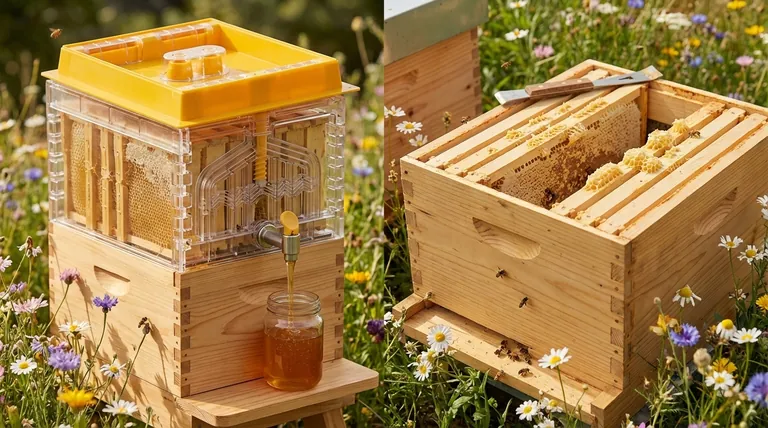In short, yes. A Flow Hive uses significantly more plastic in its honey collection frames than a conventional beehive, even one that uses plastic foundations. This is due to the complex internal mechanism of the Flow Frames that allows for honey extraction directly from the hive.
The core difference is a trade-off: The Flow Hive intentionally integrates a complex plastic system to provide harvesting convenience and reduce bee disturbance, while conventional beekeeping offers beekeepers the flexibility to minimize or completely eliminate plastic from their hives.

A Tale of Two Chambers: Brood vs. Honey
To understand the plastic comparison, it's essential to distinguish between the two main parts of any modern hive: the brood chamber and the honey super.
The Flow Hive Honey Super
The defining feature of the Flow Hive is its honey super, which contains the patented Flow Frames.
These frames are intricate, pre-formed plastic honeycombs. They are designed to split internally when a lever is turned, allowing honey to flow down and out of the hive through a channel. This entire mechanism is made of plastic.
The Conventional Honey Super
In a conventional hive, the honey super offers far more material flexibility.
Beekeepers can choose frames with plastic foundation, which is a single sheet of plastic embossed with a honeycomb pattern. They can also opt for natural beeswax foundation or even use foundationless frames, encouraging bees to build their comb from scratch with no guide.
The Brood Chamber (Common Ground)
In the lower part of the hive, the brood chamber, both systems can be identical.
The brood chamber is where the queen lays eggs and the colony raises its young. In either a Flow Hive or a conventional setup, this area can use frames that allow bees to build their brood comb entirely from their own natural wax.
Understanding the Trade-offs: Convenience vs. Material
The choice between a Flow Hive and a conventional hive comes down to a clear set of priorities and accepting the associated trade-offs.
The Benefit of Plastic: Reduced Bee Disturbance
The Flow Hive's plastic mechanism is engineered for a specific purpose: a less invasive honey harvest.
By allowing honey to be drained without opening the hive, removing frames, or disturbing the bees, it significantly reduces stress on the colony. This is the primary value proposition and the reason for the plastic design.
The Flexibility of Conventional Methods
Traditional harvesting is a more involved, labor-intensive process that requires opening the hive and using extraction equipment like a centrifuge.
However, this hands-on approach gives the beekeeper complete control over the materials inside the hive. A beekeeper focused on a "natural" setup can choose to run a hive that is 100% free of plastic.
The Cost Factor
The higher upfront cost of a Flow Hive is directly tied to its complex plastic technology.
This initial expense, however, can be balanced against the fact that you do not need to purchase separate, often costly, honey extraction equipment. The plastic frames replace the need for an extractor, uncapping knives, and filters.
Making the Right Choice for Your Goal
Ultimately, neither system is inherently superior; they are simply designed for different beekeeping philosophies.
- If your primary focus is minimizing plastic: A conventional hive with foundationless frames or natural wax foundation is the only choice that can eliminate plastic entirely.
- If your primary focus is harvesting with maximum convenience and minimal bee stress: The Flow Hive is engineered specifically for this goal, but you must accept the use of plastic in the honey frames.
- If your primary focus is a balance: You can use a Flow Hive for its harvesting benefits while ensuring the brood box uses foundationless frames, thus containing the plastic only to the honey collection area.
Choosing the right hive means aligning the equipment with your personal beekeeping philosophy and goals.
Summary Table:
| Feature | Flow Hive | Conventional Hive |
|---|---|---|
| Honey Super Frames | Complex, pre-formed plastic mechanism | Plastic foundation, beeswax foundation, or foundationless |
| Primary Goal | Harvesting convenience & reduced bee disturbance | Material flexibility & beekeeper control |
| Plastic Use | High (in honey super) | Can be minimized or eliminated |
| Brood Chamber | Can be identical (plastic-free options available) | Can be identical (plastic-free options available) |
Ready to choose the right equipment for your apiary?
Whether you're a commercial beekeeper optimizing for efficiency or a distributor sourcing reliable gear, HONESTBEE supplies the durable beekeeping supplies and equipment you need to succeed. We offer a wide range of hive components and tools to support any beekeeping philosophy.
Contact our wholesale team today to discuss your needs and get a quote!
Visual Guide

Related Products
- Professional Hive Top Bee Feeder for Beekeeping
- Professional Galvanized Hive Strap with Secure Locking Buckle for Beekeeping
- Plastic Hand Crank 2 Frame Honey Extractor Low Price
- Professional Hive Front Entrance Bee Feeder
- HONESTBEE Professional Hive Top Bee Feeder Feeding Solution
People Also Ask
- How is the plywood floor fitted into the hive-top feeder? Ensure Longevity with a Floating Floor Design
- Why is a top feeder essential for bees? Ensure Colony Health and Efficiency
- Do I need an inner cover with a hive top feeder? Optimize Your Hive Setup for Healthy Bees
- What are the advantages of hive top feeders? Maximize Feeding Efficiency for Your Apiary
- What are the features of top feeders for bees? Maximize Hive Health with Safe, High-Capacity Feeding



















